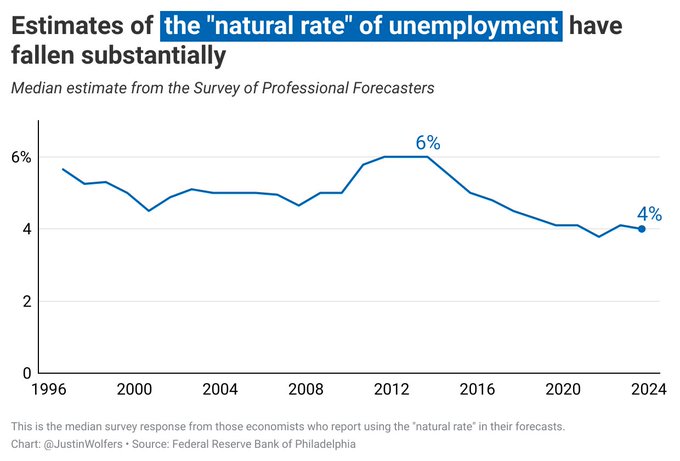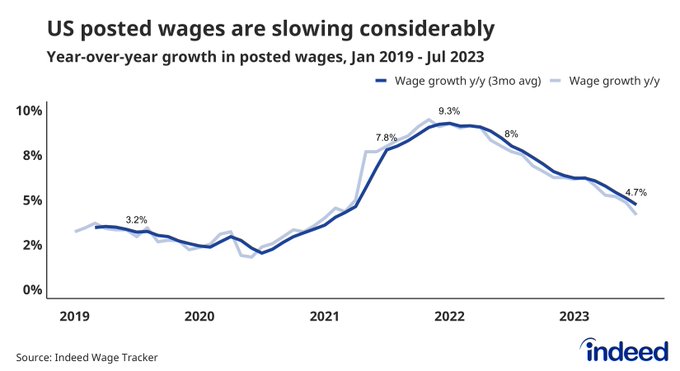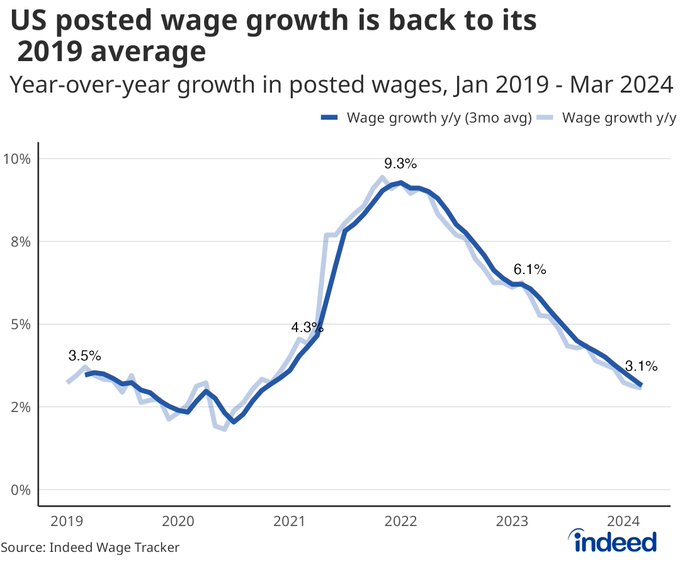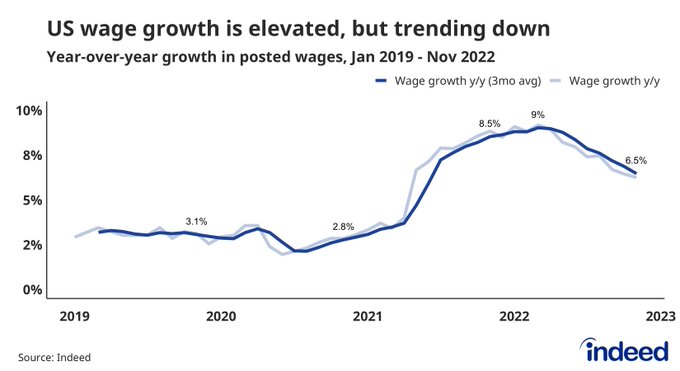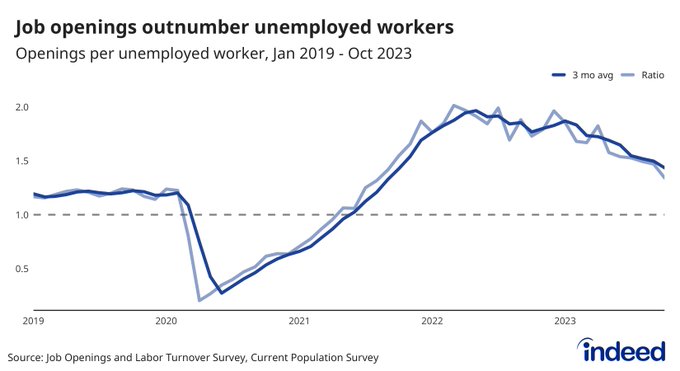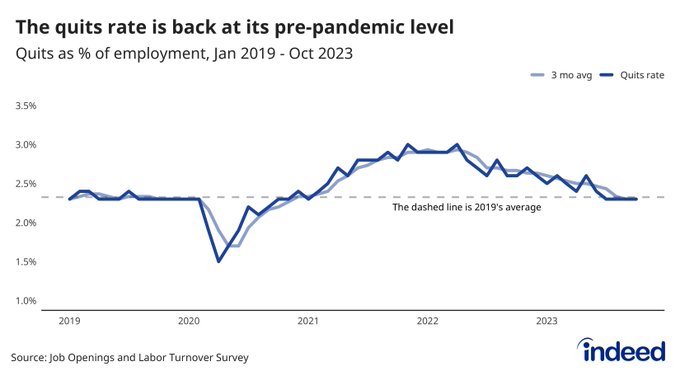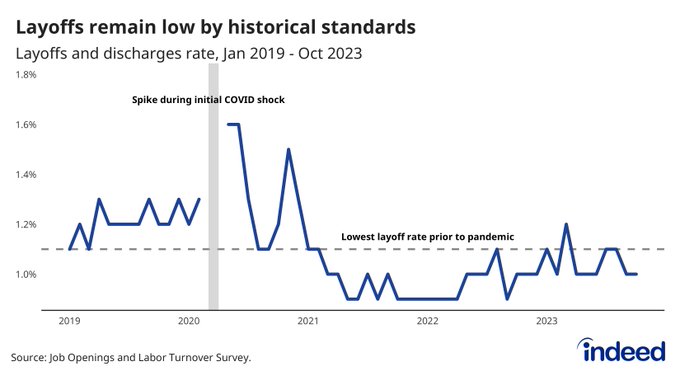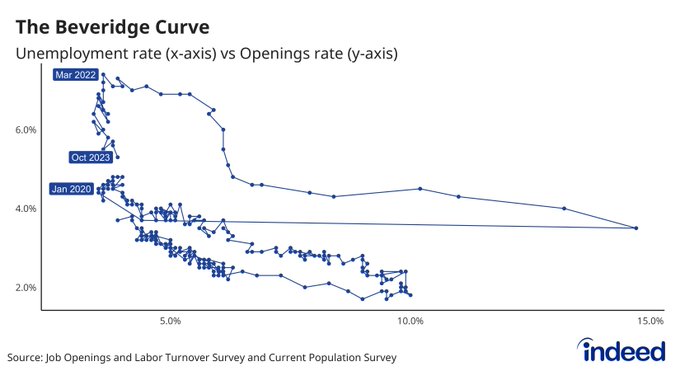
Justin Bloesch
@JustinBloesch
Followers
3,305
Following
985
Media
222
Statuses
3,301
Assistant Professor at @cornellilr & @CornellEcon . Macro, labor, inequality. "Bloesch" rhymes with "mesh".
Ithaca, NY
Joined January 2017
Don't wanna be here?
Send us removal request.
Explore trending content on Musk Viewer
Columbus
• 402353 Tweets
Bills
• 140824 Tweets
無料クーポン
• 93411 Tweets
Bret
• 91895 Tweets
Jets
• 90337 Tweets
Yankees
• 73877 Tweets
連休明け
• 72383 Tweets
#WWERaw
• 59039 Tweets
Geraldo
• 44264 Tweets
Rodgers
• 42574 Tweets
Rogan
• 32240 Tweets
Boulos
• 31272 Tweets
Soto
• 29734 Tweets
緊急入院
• 29021 Tweets
当選確率2倍
• 26631 Tweets
Hail Mary
• 25612 Tweets
Buffalo
• 20321 Tweets
Josh Allen
• 19174 Tweets
#BUFvsNYJ
• 15514 Tweets
#RepBX
• 13542 Tweets
Stanton
• 10390 Tweets
Last Seen Profiles
Pinned Tweet
A thread about why I think the soft landing has been achievable:
Wages are downwardly sticky in nominal terms, but not in real terms.
Also wage *growth* is not sticky downwards.
This matters for both a low-cost cooling of the labor market and lack of a wage-price spiral.
3
6
41
I'm excited to share that I'll be joining
@CornellEcon
and
@cornellilr
as an assistant professor in summer '23, after a postdoc at
@Columbia_Biz
and
@rooseveltinst
starting this summer.
61
5
543
Defended today! Contrary to popular belief, my committee does not entirely consist of
@bphuang12
. But she did come to celebrate with my afterwords.
18
0
214
New blog post at
@rooseveltinst
:
In 2019, the unemployment rate was 3.5%, and inflation was low and stable.
Now at the end of 2022, there's little reason to think that a rate of 3.5% is intrinsically more inflationary than it was in 2019. A thread:
8
67
196
New report at
@rooseveltinst
:
As the Fed tries to steer the economy back to normal, what inflation rate should the Fed aim for? Should it always be 2% in the future?
I argue that the Fed should adopt a target range for inflation of 2-3.5%. A thread:
13
39
154
Leisure and hospitality is kind of a residual sector of the labor market: it soaks up workers if demand is low, but workers leave it if they get better jobs.
This makes wage growth in L&H a really good indicator of labor market tightness. Tightness is falling.
6
46
137
This slowdown in wage growth happened all while the unemployment actually fell!
3
17
123
The honey badger labor market, and why it just doesn't care: (h/t
@jstalnaker1
)
1. Fewer people work in interest sensitive sectors (housing, manufacturing).
2. Those sectors were constrained anyway: still a backlog cars and homes.
5
16
114
Guess she was on
#TeamTransitory
. Love you, dear.
TFW you vowed 2 years ago to listen to
@JustinBloesch
talk about inflation, no matter how boring it got, and it got boring.
7
1
208
5
1
106
A quick thread on why student workers as the Harvard Graduate Student Union (HGSU-UAW) are planning to go on strike on December 3rd.
(Article with fellow bargaining committee members
@CherrieBucknor
and Hector Medina.)
1
66
100
It needs to be abundantly clear that if the Fed really does try to get the unemployment rate above 4%, this is what they're throwing away.
4
35
101
As they should. Estimates of a 6% natural unemployment rate in the 2010’s was badly wrong and limited what policymakers thought was possible.
6
18
87
New post at
@rooseveltinst
: Still on the path to a soft landing.
TLDR: The labor market is a only a bit tighter than it was in 2018-2019, and that's good.
We address 2 issues: time trends in JOLTS vacancies, and composition in average hourly earnings.
3
21
90
Hard to look at this and say this is a labor market that is 'out of balance' or 'too hot'.
This is a labor market that is gradually returning to normal, but a much better version of "normal" than we were used to for the last 25 years.
The descent of posted wage growth is picking up. 💰 📉
Posted wages grew 4.7% year-over-year as of July, according to the latest data from the
@indeed
Wage Tracker. That’s down from 5.1% in June and 6.2% at the beginning of the year.
6
29
96
6
18
69
Shame on the
@Columbia
administration. This level of police response to a student protest is an abomination.
4
5
67
I don’t think this is a good model for how wages are set.
Most workers don’t have the power to bargain based on cost of living, especially not lower-wage workers who tend be most renters.
8
9
66
Paper thread time! "Do Cost-of-Living Shocks Pass Through to Wages?" with
@seung_econ
and
@jacobpweber
.
Main takeaway: if firms set wages and workers search on the job, pass-through of cost of living to wages is negligible.
1
10
53
I think of wage growth in leisure & hospitality as a bit of a canary in the coal mine for the labor market: workers are short term, have little firm-specific hold-up power. Labor market tightness should matter a lot for wage growth.
This is consistent with falling tightness.
3
9
48
Tight labor markets are good!
Racial disparity in household incomes of Minnesotans is starting to narrow, reports
@kavitakumar
@StarTribune
.
0
3
6
0
9
46
Embedded in this number is some union catch-up: wage growth YoY for unionized workers was 6.5%. For non-union workers, it was 3.8%.
1
18
47
With all this wage deceleration, if you're using a standard wage Phillips curve, you'd have to infer that u*<3.5%...
6
10
45
A lot of attention on CPI today, but multiple series point to slower wage growth.
Hard to have sustained high inflation if wage growth is going back to normal.
6
7
46
A “soft landing”, where inflation comes down and unemployment stays low, has been in the cards since the hiring and quit rates started returning to normal last autumn.
Nice to see more people joining the party. :)
New blog post at
@rooseveltinst
:
In 2019, the unemployment rate was 3.5%, and inflation was low and stable.
Now at the end of 2022, there's little reason to think that a rate of 3.5% is intrinsically more inflationary than it was in 2019. A thread:
8
67
196
3
5
44
Looks to me like quits came down without an increase in the unemployment rate.
2
3
44
It also helps square why the labor numbers look so good while GDP was flat - all GDP declines from manufacturing & construction, while labor intensive sectors (health care, professional/scientific, accommodation & food service) keep growing.
@bencasselman
2
25
42
@JosephPolitano
Sure, new tenant repeat rent is cool, but have you tried the Indeed wage tracker?
@nick_bunker
@PrestonMui
New from me at
@employamerica
: The Indeed Wage Tracker Shows Wage Deceleration. The Fed Should Pay Attention.
3
14
68
1
4
40
The labor market is now less tight than in 2018-2019, and it doesn't appear to be stabilizing.
(figure thanks to
@IrvingSwisher
)
1
14
42
The more time passes, the more I like gross (nominal) labor income as the indicator for "is demand growing at a good pace?".
@IrvingSwisher
2
6
37
YESSS INDEED WAGE TRACKER FOR THE US
🚨 📉 New from the Indeed Hiring Lab:
Growth in wages advertised in
@Indeed
US job postings was elevated at 6.5% in November, but down substantially from 9% back in March.
/1
6
68
204
1
2
35
Here's the updated implied 3 month growth rate for the Atlanta Fed wage tracker.
I do the same procedure on the
@indeed
posted wage growth series shared by
@nick_bunker
.
Both are coming in at 4.7%-4.8% annualized.
A thread on labor market data:
3
8
31
Really nice episode with
@joelle_gamble
. One point I want to add to
@TheStalwart
's question about real wages:
Real wages have almost nothing to do with labor market tightness when the main shock moving prices is gasoline or used cars.
NEW ODD LOTS:
While inflation gets all the attention, there's still a lot of ambiguity about the state of the labor market.
@tracyalloway
and I spoke to
@USDOL
Chief Economist
@joelle_gamble
, who helped clear it all up, and explain the current trends
10
9
69
2
4
33
One of the wonders of tight labor markets. I love it.
New from
@CoryStahle
: a deep dive into the state of educational requirements in job postings.
💥 More than half of postings don't mention an educational requirement
💥 Share of postings requiring at least a bachelor's degree down to below 18%
2
13
53
1
10
32
I can't help but think we estimated flat Phillips curves because... we were on the flat part of the Phillips curve.
A point
@GagnonMacro
has been making for a long time.
1
5
32
Cool figures from
@IrvingSwisher
here. Relates to a project
@jacobpweber
and I have just finished a draft on - private investment spending generates a lot less domestic labor income than it used to!
2
4
31
@ModeledBehavior
My hunch is that demand elasticities fall (people are less price sensitive) when inflation goes up.
Easy to discern relative price changes increases if overall prices are stable. Much harder to tell when all prices are going up.
2
4
31
I was really intrigued by
@Econ_Parker
's split between wage growth in service/good sectors.
I think there's a good case that the growth in wages in the goods sector reflect catch-up growth, rather than inflation expectations/entrenchment.
3
5
31
Lack of construction layoffs (as a reason for a soft landing/no layoffs in response to higher interest rates) isn't even the biggest news here.
Historically, job losses in durable goods manufacturing has been much larger that job losses in construction. No layoffs jump either.
Interesting data thread. His conclusion is that surprisingly strong construction labor markets are key.
Agreed;
@JustinBloesch
and I recently argued here their backlogged nature are one of 4 reasons the Fed can have a soft landing if they want.
1
6
24
4
3
31
Two more series that show that the labor market has become a lot less tight in the last two years.
1. Job leavers share of unemployed is back down: suggests that fewer people are quitting without a job lined up.
@DeanBaker13
1
4
30
@NickTimiraos
Why is the default 'without a large increase in labor supply'?
3
4
29
Great to talk to
@denitsa_tsekova
at
@YahooFinance
about our paper (with
@BirtheLarsenCph
and
@Bledi_Taska
) and why wages at the bottom are rising.
In short: low-wage workers depend on tight labor markets to get raises in the US.
2
9
28
@jasonfurman
As you say, we shouldn't read too much into one month.
This report is *really* looks consistent with gradual cooling to me.
1
9
27
With a time trend in job openings, we are likely no longer on the ‘vertical’ part of the beveridge curve: fewer job openings means higher unemployment now. Steady should now be the goal.
Inflation was low pre-COVID with unemployment under 4%. No reason that’s not possible now.
0
3
25
@TheStalwart
Unless you understood that labor income is less sensitive to interest rates than before, and that constrained sectors (like construction and autos) wouldn’t shed workers like usual 😉
4
2
23









































